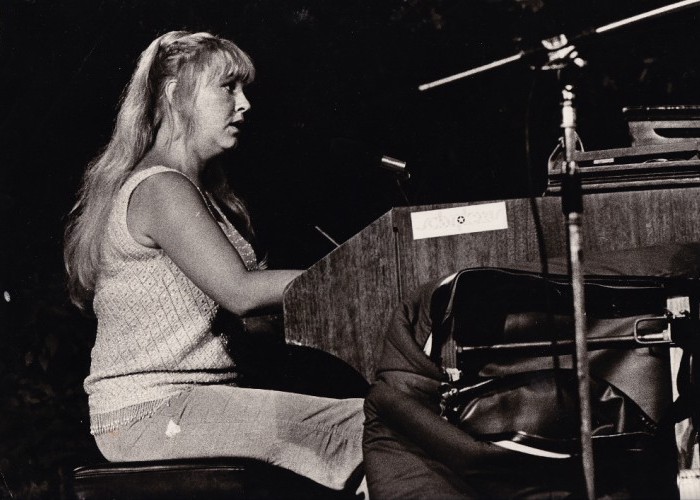Apr 2, 2024 12:59 PM
Saxophonist, Sonic Explorer Casey Benjamin Dies at 45
Casey Benjamin, the alto saxophonist, vocalist, keyboardist and producer who stamped his distinctive sounds on the…

Pianist Monica Dominique is featured on a box set that anthologizes Swedish jazz between 1970 and 1979.
(Photo: Courtesy Caprice Records)Two decades ago, the Swedish state-run label Caprice Records launched a remarkably inclusive series intended to encapsulate the country’s rich jazz history reaching all the way back to 1899, before the genre was recognized as a thing here in the U.S., let alone Europe. But that reach speaks to the wide-eared rigor of this series, which has used a non-hierarchical aesthetic in chronicling the entire sweep of jazz through 10 other volumes. The previous installment in the series, which covered 1965–1969, dropped back in 2005, so it’s heartening to see its resumption with the four-disc set Swedish Jazz History Vol. 11: Jazz Cosmopolit (Caprice 22067; 79:43/79:43/77:38/79:34 ***), which covers the years 1970–1979.
Sweden embraced jazz early on and enjoyed a long tradition of hosting visiting American musicians, and eventually some prominent players settled there—including bassist Red Mitchell and trumpeters Bill Barron and Don Cherry. Naturally, a lot of the music on this set reflects contemporaneous developments in American jazz, whether fusion or pop-inflected sounds, such as the way Georg Wadenius, a one-time member of Blood, Sweat & Tears, sings along with his guitar lines, à la George Benson, on “Birth Cry, Part 1,” a 1977 track by Sansara Music Band. Perhaps because of those connections to U.S. performers, the country produced plenty of high-level musicians, and some of the most important are prominently featured: bassist Georg Riedel offers sleek big band arrangements with Radiojazzgruppen on “Svit Cosmopolit,” while tenor titan Bernt Rosengren leads a quartet on an unexpected treatment of Ornette Coleman’s “Ramblin’.” The elegant baritone saxophone hero Lars Gullin, one of the first Swedes to score an American record deal and make inroads in the U.S., also appears with Radiojazzgruppen on a 1976 recording.
Because the music is sequenced in strict chronological fashion, the set sometimes has the effect of inducing stylistic whiplash, veering from the organ jazz of Takt & Ton to the trad ebullience of Kustbandet to the singular avant-garde guitar explorations of Staffan Harde—and that’s just during the first part of disc one.
At the same time, the level playing field for all styles is admirable. The set is packaged with a 188-page booklet crammed with photos, but most of the annotations are in Swedish. There is an overview essay in English by British critic Stuart Nicholson that gamely tries to tie it all together, as well as a brief piece that focuses on the ascent of female jazz musicians in Sweden during this era; these are followed by English-language summaries of longer Swedish pieces profiling saxophonist Lennart Åberg and singer-pianist Monica Dominique. Indeed, both Åberg, who emerged as a dominant, ubiquitous force in Swedish jazz during the ’70s—especially through his membership in Rena Rama alongside pianist Bobo Stenson—and Dominique are influential representatives.
Abundantly clear on some of the tracks here is Sweden’s importance in pushing post free-jazz sounds, whether the post-Ayleresque frenzies of the Mount Everest Trio (which tackles the saxophonist’s classic “Spirits”), the white-knuckle complexity of Lokomotiv Konkret, the high-velocity cluster-splatter attacks of pianist Per Henrik Wallin and the strident sprawl of Iskra. Perhaps more importantly, following Cherry’s residence in Sweden, the country became a font of groups borrowing elements and ideas from various international traditions, whether Sevda’s bracing pan-global concoctions or the Bulgarian themes that turn up in a track by Okay Temiz, a Turkish expat.
New York wasn’t the only melting pot during the ’70s. DB

Benjamin possessed a fluid, round sound on the alto saxophone, and he was often most recognizable by the layers of electronic effects that he put onto the instrument.
Apr 2, 2024 12:59 PM
Casey Benjamin, the alto saxophonist, vocalist, keyboardist and producer who stamped his distinctive sounds on the…

“He’s constructing intelligent musical sentences that connect seamlessly, which is the most important part of linear playing,” Charles McPherson said of alto saxophonist Sonny Red.
Feb 27, 2024 1:40 PM
“I might not have felt this way 30 to 40 years ago, but I’ve reached a point where I can hear value in what people…

Albert “Tootie” Heath (1935–2024) followed in the tradition of drummer Kenny Clarke, his idol.
Apr 5, 2024 10:28 AM
Albert “Tootie” Heath, a drummer of impeccable taste and time who was the youngest of three jazz-legend brothers…

“Both of us are quite grounded in the craft, the tradition and the harmonic sense,” Rosenwinkel said of his experience playing with Allen. “Yet I felt we shared something mystical as well.”
Mar 12, 2024 11:42 AM
“There are a few musicians you hear where, as somebody once said, the molecules in the room change. Geri was one of…

Larry Goldings’ versatility keeps him in high demand as a leader, collaborator and sideman.
Feb 21, 2024 10:45 AM
Are you having any fun? Larry Goldings certainly is. Consider just two recent examples:
Scene 1: “If anyone had…